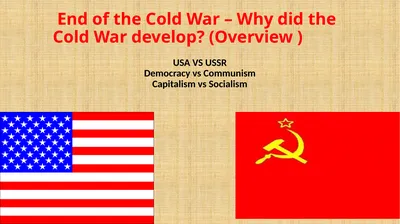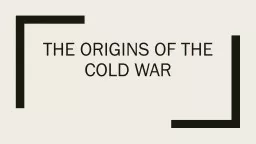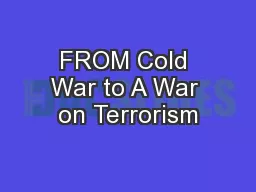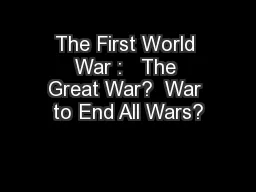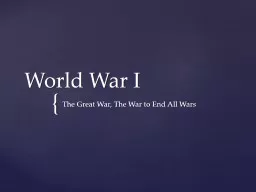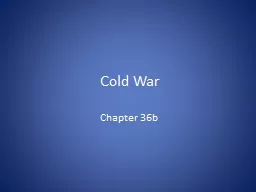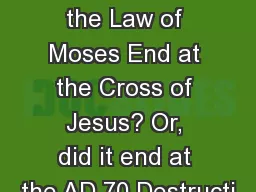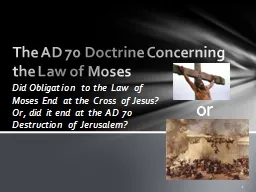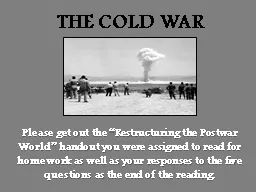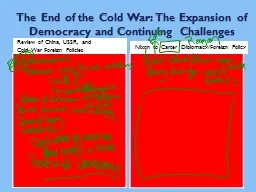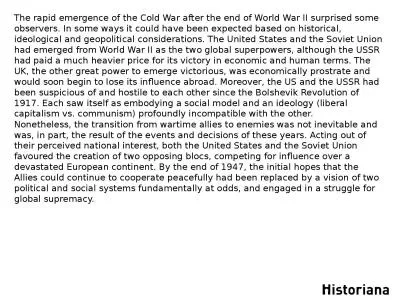PPT-End of the Cold War – Why did the Cold
Author : pasty-toler | Published Date : 2025-07-18
End of the Cold War Why did the Cold War develop Overview USA VS USSR Democracy vs Communism Capitalism vs Socialism COLD WAR Characteristics Political Strategic
Presentation Embed Code
Download Presentation
Download Presentation The PPT/PDF document "End of the Cold War – Why did the Cold" is the property of its rightful owner. Permission is granted to download and print the materials on this website for personal, non-commercial use only, and to display it on your personal computer provided you do not modify the materials and that you retain all copyright notices contained in the materials. By downloading content from our website, you accept the terms of this agreement.
End of the Cold War – Why did the Cold: Transcript
End of the Cold War Why did the Cold War develop Overview USA VS USSR Democracy vs Communism Capitalism vs Socialism COLD WAR Characteristics Political Strategic and Ideological struggle between the USA and USSR Spreading through. ‘Peace Through Strength’. or. ‘New Thinking’. Orthodox. The first school of interpretation to emerge in the U.S. was "orthodox". For more than a decade after the end of the Second World War, few U.S. historians challenged the official U.S. interpretation of the beginnings of the Cold War.. The Origins of the Cold War. The Yalta Conference (Feb. 1945, Crimean coast) is often considered the starting point of Cold War tensions between the US and the Soviet Union. ‘Big Three’ – Roosevelt, Churchill, Stalin were present. . Prosperity at Home, Cold War Abroad. The U.S. had tremendous prosperity in the 1950s – with an increase in national income each year.. But to counter the spread of Soviet influence, the U.S. also maintained a peacetime draft (Universal Military Training), and a large peacetime army, navy, and air force.. Chapters 22-25 . History Alive!. , Ch. 11 . Americans. History Alive!. . Ch. . 22: From Neutrality to War . p. . 283-291. “Was it in the national interest of the US to stay neutral or declare war in 1917?”. M – . Militarism. : Fascination with war and a strong military. A – . Alliances. : Agreements among varying nations to help each other out. I – . Imperialism. : Building empires and competition for markets. By end of WWII, alliance between G.B., U.S., and U.S.S.R. disintegrating. Cold war = competition for global influence between democracy/capitalism and communism. Led to: alliances (-> “iron curtain”), client states, arms race, diplomatic . La gamme de thé MORPHEE vise toute générations recherchant le sommeil paisible tant désiré et non procuré par tout types de médicaments. Essentiellement composé de feuille de morphine, ce thé vous assurera d’un rétablissement digne d’un voyage sur . The AD 70 Doctrine Concerning the Law of Moses. or. 1. The Law of Moses did NOT cease to testify of Christ. The Law of Moses did NOT cease to testify of sin and guilt. The Law of Moses did NOT cease to be scripture that gives “instruction in righteousness” (2 Tim.3:15-17). SEO is anything but a “one size fits all” strategy. What works for one website may not work for another. And what worked for you in the past may not yield the same results in the future. The AD 70 Doctrine Concerning the Law of Moses. or. 1. The Law of Moses did NOT cease to testify of Christ. The Law of Moses did NOT cease to testify of sin and guilt. The Law of Moses did NOT cease to be scripture that gives “instruction in righteousness” (2 Tim.3:15-17). If your cold emails do not match these standards then yes, you’ve got to go back and revise them. Yes, that’s a pain, but at least you’ll know what to do the next time around. THE COLD WAR Please get out the “Restructuring the Postwar World” handout you were assigned to read for homework as well as your responses to the five questions as the end of the reading. READING QUIZ Review of China, USSR, and. Cold War Foreign Policies. Nixon to Carter Diplomacy/Foreign Policy. Cold War . 1949-1991 – USSR/US. Space race, Berlin Wall, Korean War, Vietnam War, Cuba, culture in US. Nonetheless, the transition from wartime allies to enemies was not inevitable and was, in part, the result of the events and decisions of these years. Acting out of their perceived national interest, both the United States and the Soviet Union favoured the creation of two opposing blocs, competing for influence over a devastated European continent. By the end of 1947, the initial hopes that the Allies could continue to cooperate peacefully had been replaced by a vision of two political and social systems fundamentally at odds, and engaged in a struggle for global supremacy..
Download Document
Here is the link to download the presentation.
"End of the Cold War – Why did the Cold"The content belongs to its owner. You may download and print it for personal use, without modification, and keep all copyright notices. By downloading, you agree to these terms.
Related Documents

